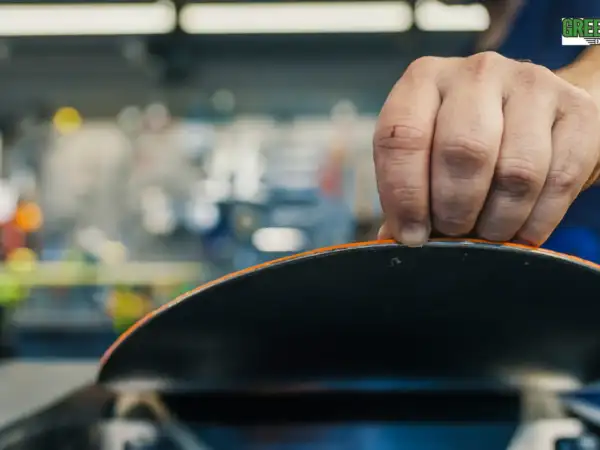Are you looking for a thrilling ride on snow? Ever thought about how important skis are for this? Learning to ski tuning is crucial. It maximizes performance and keeps your skis lasting longer.
This guide covers key waxing methods, beveling techniques, and how to maintain your ski’s base. It’s aimed at both seasoned skiers and newbies. You’ll learn how to tune your skis like a professional, enhancing your skiing adventures.
Key Takeaways
- Regular waxing is crucial for maintaining optimal glide and preventing dryness.
- Edge beveling and deburring ensure precise control and grip on challenging terrain.
- Proper base maintenance, including scraping and ironing, enhances overall ski performance.
- Using the right diamond stonesstone>, scrapers, and wax ironsiron> is essential for successful ski tuningtuning>.
- Regular tuning and maintenance extend the lifespan of your skis and snowboards.
Understanding the Importance of Ski Maintenance
It’s key to keep our skis or snowboards well-maintained. This means they perform at their best, keep us safe, and last longer. Regular tuning and waxing help us control and grip the slopes. They also lower the chance of accidents from sharp edges.
Increased Lifespan and Performance
Skis or snowboards that are kept up feel smoother, handle better, and grip the snow well. By tuning and waxing, we keep the bases from drying out. This makes our gear last longer. No matter if we ski professionally or just for fun, taking care of our equipment improves how it works and how long it lasts.
Safety Precautions
Ignoring maintenance is dangerous. Rough edges reduce our ability to steer well, which might cause accidents. By regularly fixing edges and making them smooth, we ensure our equipment responds as it should. This lets us feel secure on any slope during the skiing season.
Annual Professional Check-up
We can do basic maintenance, like waxing, at home. But it’s smart to get our gear checked by pros once a year. Ski experts can spot and fix big issues. This prep our equipment for more DIY maintenance and the ski season ahead.
Cleaning and Storing Your Skis
Keeping skis clean and stored right is key for their lifespan and performance. After a day of skiing, it’s vital to look after the ski base and all your gear well.
Drying and Wiping Down Skis
Start by drying and wiping your skis each time you use them. This prevents rust and keeps the ski base in good shape. Always make sure the skis are completely dry to avoid problems.
Proper Storage Conditions
Once your skis are dry, store them in a safe place. A cool, dry spot with good air flow is best. Keep the skis upright and apart to avoid damage. Also, keep them out of the sun to prevent wear.
Seasonal Waxing and Inspection
Before you put your skis away for the season, check them for any harm and wax them. This protects the ski base and keeps the skis in great shape for the next use. You could also use a base conditioner for extra care.
Doing these things helps your skis last longer and work better. It saves money and lets you enjoy your skiing without worry. Just remember to give your skis a good check and tune-up before hitting the slopes.
Inspecting Your Skis for Damage
As keen skiers, we know how vital it is to look after our skis. Regular check-ups help them last longer and work better. It’s key to check our ski edges and the base of the ski for signs of base damage or wear after a few outings.
Checking Base Condition
The skis’ base is very important for how they perform. Watch for any dullness, scratches, or gouges. These might mean it’s time for base damage repair or a new wax coat. A dry base makes it hard to slide on the snow, which can affect your control and fun on the slopes.
Examining Edge Sharpness
Having sharp ski edges is vital for snow grip, especially on ice or hard snow. It’s good to sharpen them every 10 days for best performance. Run a clean towel on the edges to find any nicks or burrs. These could make them less sharp and less able to grip the snow.
Identifying Burrs and Nicks
When looking at your ski edges, also check for burrs or nicks. They form with use or bad storage. These flaws can catch the snow, making you lose balance or get hurt. For big nicks or burrs, it’s smart to get your skis fixed or tuned at a local ski shop.
Check your skis often and fix problems right away. This keeps them in good shape and you safer and happier on the mountain. Remember, well-kept gear is key for top performance and confidence while skiing.
Essential Tuning Tips for Skis
It’s key to keep your skis in top shape for a great time on the slopes. The right tuning ensures they perform well and last longer. We’ll show you the necessary tuning tools and steps to take care of your pair of skis.
Tools and Equipment Needed
First, gather the right hand tools for tuning. You’ll need files, diamond stones, bevel guides, brushes, and a wax iron. Also, make sure you have a sturdy workbench and a ski vise. These tuning tools are essential for a job well done.
Basic Edge Tuning Process
Sharp, clean edges are crucial for ski upkeep. Examine your skis by feeling the edges with your fingernail. Use a diamond stone grind to remove any rough spots. Focus on the base edge bevel and the sides. Be careful not to damage the ski’s base while grinding.
Waxing Techniques
Waxing protects the ski bases and helps you glide smoothly on the snow. Clean the bases well before you start. Then, spread melted wax all over and let it cool. Scrape off the extra wax with a plastic scraper. Finally, use brushes to get the wax deep into the base for a fast, water-resistant finish.
Tuning skis at home is possible with the right tools. Yet, getting a professional done at a ski shop is smart, especially at the season’s beginning. It ensures your equipment is in top shape, making your ski trips safer and more fun.
Binding Maintenance and Adjustment
It’s not just your skis that need tuning and waxing. It’s equally important to look after your bindings. Before you ski, check your skis and bindings really well.
Binding Inspection and Lubrication
Make sure you often look at your bindings for snow. To stop snow from sticking, you can use a file or special lubricant. This means they will work smoothly and release when you fall.
Mounting Screw Tightness
Checking how tight the mounting screws are is super important. Loose screws can make your bindings not work right, which can be risky. Don’t forget to do this when tuning your own skis.
Professional Binding Adjustment
Some binding tweaks we can do at home. But, for the best fit and safety, it’s smart to get a pro to install them first. Don’t force or tweak them too much, as that might make them unsafe.
Looking after your bindings means they will last longer and keep you safer. Keep them clean and well-lubricated. Also, get them checked by a pro every now and then.
| Binding Maintenance Task | Frequency | Importance |
|---|---|---|
| Inspect for snow buildup | Before each ski day | Prevents sticking and ensures smooth release |
| Check mounting screw tightness | Monthly | Maintains binding performance and safety |
| Professional binding adjustment | Annually or after significant changes | Ensures proper fit and calibration for safety |
Advanced Repair Tips
Proper ski maintenance is key for better control and top-notch slope performance. Some basic tuning is easy to do at home, but advanced repair demands more skill and focus.
Minor Base Repairs with P-Tex
Tackling small base scratches or gouges at home is doable. You just need P-Tex candles and a scraper. Melt the P-Tex, drip it on the scratch, then scrape for a smooth finish.
This method is great for light damage, like small core shots or narrow scratches. For bigger base harms, professional help is wise. They ensure your skis stay safe and strong.
Edge Deburring and Polishing
Keeping your edges smooth is crucial for ski maintenance. Edges can get burred or nicked, hurting your control and snow grip. Using tools like diamond stones and gummy stones helps.
Running a heavy and light diamond stone over the edges removes burrs. This keeps the edges sharp and your ski’s performance high. It also makes your skis last longer.
These advanced skills are worth learning for your home ski maintenance. They help you keep flat bases and sharp edges. This ensures your skis work great for years.
Conclusion
Taking good care of your skis is super important. It makes sure they work well, are safe, and last a long time. Daily checks like ski waxing, sharpening the edges, and fixing small issues can be done at home. But, getting your skis checked by a pro every year is a smart move.
For those who like DIY tuning, get quality tools. A waxing iron, files, a side edge guide, and scrapers are a must. After waxing, scrape the excess wax for the best performance.
Also, don’t forget about base repairs. You can do small fixes yourself. But, leave big fixes to the pros. Regular care, like waxing and maintaining your edges, will ensure you have a smooth skiing experience.




